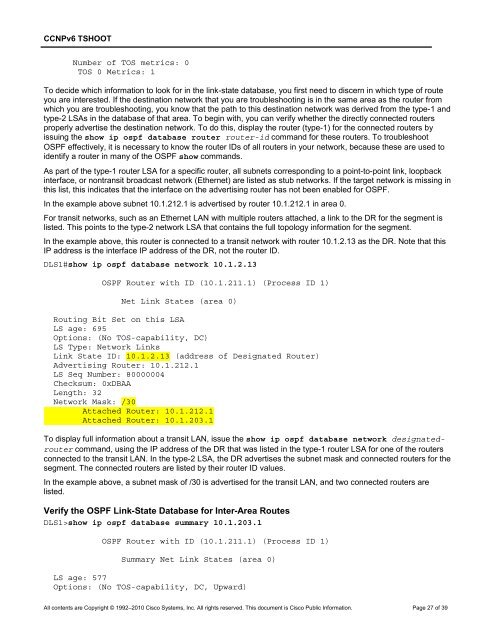CCNP TSHOOT 6.0 - The Cisco Learning Network
CCNP TSHOOT 6.0 - The Cisco Learning Network
CCNP TSHOOT 6.0 - The Cisco Learning Network
You also want an ePaper? Increase the reach of your titles
YUMPU automatically turns print PDFs into web optimized ePapers that Google loves.
<strong>CCNP</strong>v6 <strong>TSHOOT</strong><br />
Number of TOS metrics: 0<br />
TOS 0 Metrics: 1<br />
To decide which information to look for in the link-state database, you first need to discern in which type of route<br />
you are interested. If the destination network that you are troubleshooting is in the same area as the router from<br />
which you are troubleshooting, you know that the path to this destination network was derived from the type-1 and<br />
type-2 LSAs in the database of that area. To begin with, you can verify whether the directly connected routers<br />
properly advertise the destination network. To do this, display the router (type-1) for the connected routers by<br />
issuing the show ip ospf database router router-id command for these routers. To troubleshoot<br />
OSPF effectively, it is necessary to know the router IDs of all routers in your network, because these are used to<br />
identify a router in many of the OSPF show commands.<br />
As part of the type-1 router LSA for a specific router, all subnets corresponding to a point-to-point link, loopback<br />
interface, or nontransit broadcast network (Ethernet) are listed as stub networks. If the target network is missing in<br />
this list, this indicates that the interface on the advertising router has not been enabled for OSPF.<br />
In the example above subnet 10.1.212.1 is advertised by router 10.1.212.1 in area 0.<br />
For transit networks, such as an Ethernet LAN with multiple routers attached, a link to the DR for the segment is<br />
listed. This points to the type-2 network LSA that contains the full topology information for the segment.<br />
In the example above, this router is connected to a transit network with router 10.1.2.13 as the DR. Note that this<br />
IP address is the interface IP address of the DR, not the router ID.<br />
DLS1#show ip ospf database network 10.1.2.13<br />
OSPF Router with ID (10.1.211.1) (Process ID 1)<br />
Net Link States (area 0)<br />
Routing Bit Set on this LSA<br />
LS age: 695<br />
Options: (No TOS-capability, DC)<br />
LS Type: <strong>Network</strong> Links<br />
Link State ID: 10.1.2.13 (address of Designated Router)<br />
Advertising Router: 10.1.212.1<br />
LS Seq Number: 80000004<br />
Checksum: 0xDBAA<br />
Length: 32<br />
<strong>Network</strong> Mask: /30<br />
Attached Router: 10.1.212.1<br />
Attached Router: 10.1.203.1<br />
To display full information about a transit LAN, issue the show ip ospf database network designatedrouter<br />
command, using the IP address of the DR that was listed in the type-1 router LSA for one of the routers<br />
connected to the transit LAN. In the type-2 LSA, the DR advertises the subnet mask and connected routers for the<br />
segment. <strong>The</strong> connected routers are listed by their router ID values.<br />
In the example above, a subnet mask of /30 is advertised for the transit LAN, and two connected routers are<br />
listed.<br />
Verify the OSPF Link-State Database for Inter-Area Routes<br />
DLS1>show ip ospf database summary 10.1.203.1<br />
OSPF Router with ID (10.1.211.1) (Process ID 1)<br />
Summary Net Link States (area 0)<br />
LS age: 577<br />
Options: (No TOS-capability, DC, Upward)<br />
All contents are Copyright © 1992–2010 <strong>Cisco</strong> Systems, Inc. All rights reserved. This document is <strong>Cisco</strong> Public Information. Page 27 of 39

















